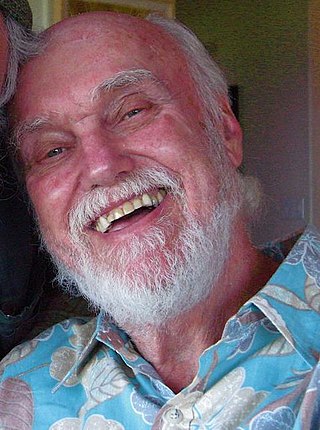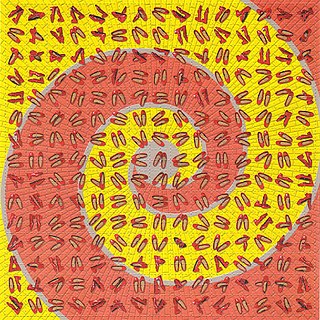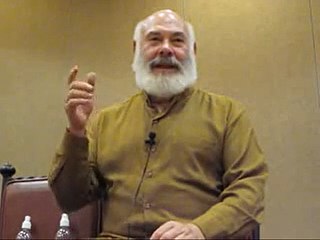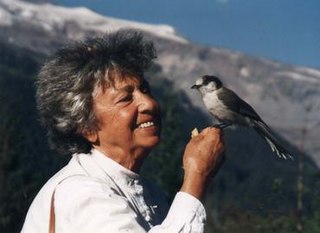
Timothy Francis Leary was an American psychologist and author known for his strong advocacy of psychedelic drugs. Evaluations of Leary are polarized, ranging from bold oracle to publicity hound. According to poet Allen Ginsberg, he was "a hero of American consciousness", and writer Tom Robbins called him a "brave neuronaut". During the 1960s and 1970s, Leary was arrested 36 times; President Richard Nixon allegedly described him as "the most dangerous man in America".

Psilocybin is a naturally occurring psychedelic prodrug compound produced by more than 200 species of fungi. The most potent are members of genus Psilocybe, such as P. azurescens, P. semilanceata, and P. cyanescens, but psilocybin has also been isolated from about a dozen other genera. Psilocybin is itself biologically inactive but is quickly converted by the body to psilocin, which has mind-altering effects similar, in some aspects, to those of lysergic acid diethylamide (LSD), mescaline, and dimethyltryptamine (DMT). In general, the effects include euphoria, visual and mental hallucinations, changes in perception, distorted sense of time, and perceived spiritual experiences. It can also cause adverse reactions such as nausea and panic attacks.

Ram Dass, also known as Baba Ram Dass, was an American spiritual teacher, guru of modern yoga, psychologist, and writer. His best-selling 1971 book Be Here Now, which has been described by multiple reviewers as "seminal", helped popularize Eastern spirituality and yoga in the West. He authored or co-authored twelve more books on spirituality over the next four decades, including Grist for the Mill (1977), How Can I Help? (1985), and Polishing the Mirror (2013).

Psilocybin mushrooms, commonly known as magic mushrooms, are a polyphyletic informal group of fungi that contain psilocybin, which turns into psilocin upon ingestion. Biological genera containing psilocybin mushrooms include Psilocybe, Panaeolus, Inocybe, Pluteus, Gymnopilus, and Pholiotina.
Psychedelic therapy refers to the proposed use of psychedelic drugs, such as psilocybin, MDMA, LSD, and ayahuasca, to treat mental disorders. As of 2021, psychedelic drugs are controlled substances in most countries and psychedelic therapy is not legally available outside clinical trials, with some exceptions.
Alfred Matthew Hubbard, was an early proponent for the drug LSD during the 1950s. He is reputed to have been the "Johnny Appleseed of LSD" and the first person to emphasize LSD's potential as a visionary or transcendental drug.

The psychedelic drug lysergic acid diethylamide (LSD) was first synthesized on November 16, 1938, by the Swiss chemist Albert Hofmann in the Sandoz laboratories in Basel, Switzerland. It was not until five years later on April 19, 1943, that the psychedelic properties were found.

Andrew Thomas Weil is an American medical doctor who advocates for integrative medicine including the 4-7-8 breathing technique.

The Marsh Chapel Experiment, also called the "Good Friday Experiment", was an experiment conducted on Good Friday, April 20, 1962 at Boston University's Marsh Chapel. Walter N. Pahnke, a graduate student in theology at Harvard Divinity School, designed the experiment under the supervision of Timothy Leary, Richard Alpert, and the Harvard Psilocybin Project. Pahnke's experiment investigated whether psilocybin would act as a reliable entheogen in religiously predisposed subjects.

The Concord Prison Experiment, conducted from 1961 to 1963, was designed to evaluate whether the experiences produced by the psychoactive drug psilocybin, derived from psilocybin mushrooms, combined with psychotherapy, could inspire prisoners to leave their antisocial lifestyles behind once they were released. How well it worked was to be judged by comparing the recidivism rate of subjects who received psilocybin with the average for other Concord inmates.
Michael Hollingshead (?–1984?) was a British researcher who studied psychedelic drugs, including psilocybin and LSD, at Harvard University in the mid-20th century. He was the father of comedian Vanessa Hollingshead. He evangelized the use of LSD to many notable figures.

High Priest is a 1968 book by American psychologist and writer Timothy Leary, published by New American Library. Written before Leary's incarceration on drug-related charges, it is an autobiographical account of his experiences from 1959 to 1962, a period that roughly coincides with his employment as a lecturer in clinical psychology at Harvard University.
Walter Norman Pahnke was a minister, physician, and psychiatrist most famous for the "Good Friday Experiment", also referred to as the Marsh Chapel Experiment or the "Miracle of Marsh Chapel".

League for Spiritual Discovery (LSD) was a spiritual organization inspired by the works of Timothy Leary, and strove for legal use of lysergic acid diethylamide (LSD) for the purpose of meditation, insight, and spiritual understanding. It was in existence during the mid-to-late 1960s, and eventually closed by Leary. The New York Center for the League of Spiritual Discovery, in existence for around a year, was co-founded by Timothy Leary and Nina Graboi in 1966. The center was the first LSD-based meditation center in Manhattan.

The Psychedelic Experience: A Manual Based on The Tibetan Book of the Dead is a 1964 book about using psychedelic drugs that was coauthored by Timothy Leary, Ralph Metzner and Richard Alpert. All three authors had taken part in research investigating the therapeutic potential of psychedelic drugs such as LSD, psilocybin and mescaline in addition to the ability of these substances to sometimes induce religious and mystical states of consciousness.

The Zihuatanejo Project was a psychedelic training center and intentional community created during the beginning of the counterculture of the 1960s by Timothy Leary and Richard Alpert under the umbrella of their nonprofit group, the International Federation for Internal Freedom (IFIF). The community was located in Zihuatanejo, Guerrero, Mexico, and took up residence at the Hotel Catalina in the summers of 1962 and 1963.
Don Lattin is an American journalist and the author of six published books, including The Harvard Psychedelic Club and Changing Our Minds — Psychedelic Sacraments and the New Psychotherapy Lattin’s work has appeared in many U.S. magazines and newspapers, including the San Francisco Chronicle where he worked for two decades as a staff writer covering religion, spirituality and psychology.
The Leary–Lettvin debate was a May 3, 1967 debate between Dr. Jerome Lettvin, a medical doctor and professor at MIT, and Dr. Timothy Leary, a licensed psychologist, about the merits and dangers of the hallucinogenic drug LSD. It took place in the Kresge Auditorium at the Massachusetts Institute of Technology.

Nina Graboi was a Holocaust survivor, artist, writer, spiritual seeker, philosopher, and influential figure in the sixties psychedelic movement. After fleeing the Nazis in Europe and spending three months in a detention camp in North Africa, she and her husband came to United States as refugees. As a close friend and colleague of Timothy Leary's and Richard Alpert's, she was co-founder and director of the League for Spiritual Discovery's New York Center during the psychedelic era. The center was the first LSD-based meditation center in Manhattan. She also worked closely with Jean Houston, Abraham Maslow, Stanley Krippner, and Alan Watts.
Entheogenic drugs have been used by various groups for thousands of years. There are numerous historical reports as well as modern, contemporary reports of indigenous groups using entheogens, chemical substances used in a religious, shamanic, or spiritual context.













